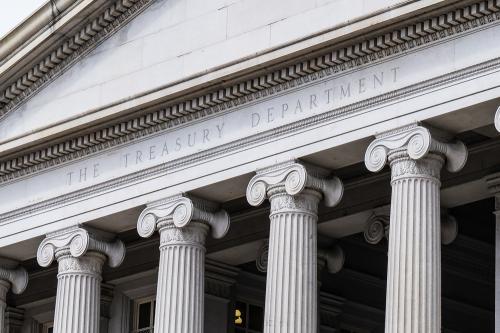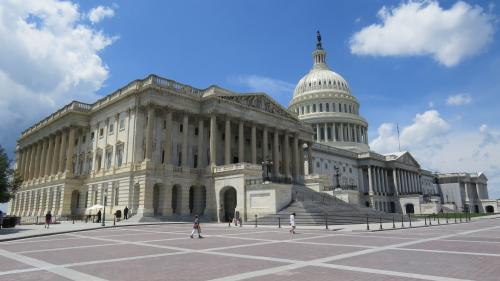On February 16, 2022, Louise Sheiner presented this testimony to the U.S. House Committee on the Budget, as part of their hearing, “Why Congress needs to abolish the debt limit.”
Chairman Yarmuth, Ranking Member Smith, and Committee members, thank you for inviting me to talk about the need to abolish the U.S. debt ceiling.
I would like to make three points today.
1. The debt ceiling does not serve any useful purpose. It has not imposed any fiscal discipline on Congress.
2. We don’t know what would happen to interest rates and the standing of the U.S. if Congress someday failed to raise the debt ceiling, but we do know the effects would be negative. This is not a risk we should take.
3. Our country faces a lot of long-term economic challenges— high levels of inequality and limited economic mobility, slow productivity growth, climate change, high health care costs, and an unsustainable trajectory for the federal debt. We should address those directly. Bickering over the debt ceiling is a waste of time and energy, creates unnecessary uncertainty, threatens the benefits of issuing the world’s safest asset and undermines public confidence in our political institutions.
The debt ceiling is a legal limit on the total amount of outstanding U.S. Federal debt. When the U.S. reaches that limit, the U.S. Treasury no longer has the authority to increase its net borrowing and can only make payments on its obligations out of incoming revenues. The debt limit does not govern the revenues and spending obligations of the federal government—those are governed by legislation enacted by current and previous Congresses. Instead, the debt limit is a political roadblock that, when reached, prevents the federal government from fulfilling its already-incurred obligations. It is like spending money and refusing to pay the credit card bill.
The debt ceiling would only be a nuisance if Congress lifted it as a matter of course whenever the need arose. However, that has not been the history in recent years. Instead, the debt ceiling has become a political weapon used to try to extract concessions or, more recently, to simply score political points. Indeed, just last fall we came within weeks of Treasury having to default on some of its obligations—before Congress acted at the last minute. That potentially included not making interest payments to debt holders on time.
Using the debt ceiling as a political weapon or as a way of trying to impose fiscal discipline is not a wise choice. At a minimum, the possibility that the federal government will not honor its debt obligations undermines confidence in the U.S. economy and in our political institutions. It also creates completely unnecessary economic stress for people, as federal employees, contractors, Social Security beneficiaries and the like have to worry about whether the government will pay them what they are owed on a timely basis. A protracted standoff in which the debt ceiling actually binds–which we have thankfully thus far avoided—risks wreaking havoc on global financial markets and permanently higher borrowing rates for the U.S. government.
Some might argue that the debt ceiling is a “necessary evil” because it provides a measure of fiscal discipline to the budget process. I think that view is misguided. First, there is little evidence that debt ceiling impasses have led to any long-term fiscal restraint. Indeed, the debt rose from 70 percent of GDP in fiscal 2011, the year the Budget Control Act was passed as part of the resolution of the 2011 debt ceiling crisis, to 79 percent of GDP in 2019, the year before COVID. This increase in borrowing reflects in part the tax cuts enacted in 2017. Second, and more importantly, the questions of how to address our long-term fiscal sustainability problem—when changes should be made, what is the mix of spending cuts and tax increases we need, which specific policies are best—are complicated and require careful deliberation. These types of fundamental policy decisions shouldn’t be made in a hurry because the economy is being held hostage. Instead, Congress should confront tax and spending issues directly, not as a byproduct to lifting the debt ceiling.
What would it mean for the debt ceiling to be binding?
It is unclear what would unfold should Treasury not have enough cash to pay all of its obligations. Although the U.S. debt has technically hit the debt ceiling limit many times over the past 12 years, in each of these cases, Treasury undertook a set of “extraordinary measures” so that the debt limit did not actually bind, and Congress raised or suspended the limit before these measures ran out.
Treasury developed a contingency plan in place in 2011 when they faced the threat of a binding debt limit, and most observers believe that the plan would have been followed in 2021 had it been needed. Under the plan, Treasury would not default on its debt—that is, Treasury would continue to pay interest on Treasury securities in a timely manner. When a security matured, Treasury would pay that principal by auctioning new securities for the same amount (and thus not increasing the overall stock of debt held by the public.) To deal with the inability to borrow, Treasury would delay payments on all of its other obligations, only making payment on a day’s worth of obligations when sufficient cash was available. In this way, Treasury would avoid picking and choosing which bills to pay and which to delay.
There is a lot of uncertainty about this plan—after all, it has never been put to the test. Some question whether Treasury’s financial systems would be able to handle these delays without technical glitches. In addition, there would likely be legal challenges to the plan, because it is questionable whether holders of Treasury securities have the right to be paid before others. It is not clear how such litigation would turn out, in part because the law itself imposes contradictory requirements on the government—requiring it to make payments, honor the debt, and not go above the debt limit, three things that cannot all happen at once.
And, importantly, the plan recognizes that all the payments will eventually be made. Contractors, Social Security beneficiaries, health care providers, employees—would all eventually be made whole. Treasury cannot unilaterally increase taxes or lower spending—these are legal obligations that only Congress can change. The only practical resolution to a debt ceiling impasse is to raise or suspend the debt ceiling. The question is just how long that takes and how costly it is.
The costs of a binding debt ceiling
In September of last fall, my colleague Wendy Edelberg and I evaluated the likely costs to the U.S. economy of a binding debt ceiling, which seemed like a real possibility at that time. We argued that these costs are enormously uncertain, as they depend on the perceptions of financial market participants, businesses and households.
If, for example, people believe that an impasse will be resolved quickly, it is possible that the initial cost to the economy would be muted. On the other hand, it’s also possible that a binding debt ceiling would have swift repercussions—perhaps the stock market would tumble the first day that a Social Security payment is delayed, and perhaps Treasury markets would seize up because participants weren’t convinced that payments would be made on time. In such a situation, even if the impasse were resolved quickly, there would be lasting damage arising from the hit to confidence in the U.S. political system.
A protracted impasse would undoubtedly have severe effects, with conditions worsening with each passing day. The sharp cut in federal spending that would be required under a binding debt limit would itself have significant macroeconomic consequences. In 2022, for example, under current law, about 20% of spending will be financed by borrowing, meaning that, on average, spending would have to be cut by at least this amount during a debt ceiling crisis. Of course, the patterns of spending and revenues vary over the year—for example, there is a large influx of revenues during tax filing months and modest revenues in other months—so the required cuts could be even larger. A 20% reduction in spending—amounting to almost 5 percent of GDP—should it persist for any significant length of time, would likely lead to a recession. Moreover, tax revenues, the only resource the Treasury would have to pay interest on the debt, would be dampened, and the federal government would have to cut back on non-interest outlays with increasing severity.
Concerns about a default would likely grow with mounting legal and political pressures as Treasury security holders were prioritized above others. Interest rates on newly-issued Treasuries would rise. If financial markets started to pull back from U.S. Treasuries all together, the Treasury could have a difficult time finding buyers when it sought to roll over maturing debt, perhaps putting pressure on the Federal Reserve to purchase additional Treasuries in the secondary market. Such financial market disruptions would very likely be coupled with declines in the price of equities, a loss of consumer and business confidence, and a contraction in access to private credit markets.
In a worst-case scenario, Treasury would be forced to delay a payment of interest or principal on U.S. debt. Such an outright default on Treasury securities would very likely result in severe disruption to the Treasury securities market with acute spillovers to other financial markets and to the cost and availability of credit to households and businesses. Those developments would undoubtedly undermine the reputation of the Treasury market as the safest and most liquid in the world.
The federal government pays a lower interest rate on Treasury securities because of the unparalleled safety and liquidity of the Treasury market. Some estimates suggest that this advantage lowers the interest rate the government pays on Treasuries (relative to interest rates on the debt of other sovereign nations) by something on the order of a quarter of a percentage point. Given the current level of the debt, this translates into interest savings for the federal government of roughly $60 billion this year, and over $700 billion over the next decade. Even if only some of this advantage were lost by allowing the debt limit to bind, the cost to the taxpayer could be significant.
While subject to great uncertainty, those analyses demonstrate that the effects of allowing the debt limit to bind could be quite severe, even if, as is assumed, principal and interest payments continued to be made. If instead the Treasury failed to fully pay all principal and interest payments—because of political or legal constraints, unexpected cash shortfalls, or a failed auction of new Treasury securities—the consequences would be even more dire.
Our country faces a lot of long-term economic challenges— high levels of inequality and limited economic mobility, slow productivity growth, the challenges of climate change, high health care costs, and an unsustainable trajectory for the federal debt. We should address those. Political bickering over the debt ceiling — which so far has always been raised or suspended — is a waste of time and energy, creates unnecessary uncertainty, threatens the benefits of issuing the world’s safest asset and undermines public confidence in our political institutions.
The Brookings Institution is financed through the support of a diverse array of foundations, corporations, governments, individuals, as well as an endowment. A list of donors can be found in our annual reports published online here. The findings, interpretations, and conclusions in this report are solely those of its author(s) and are not influenced by any donation.







Commentary
TestimonyWhy Congress needs to abolish the debt limit: Testimony before the House Budget Committee
February 22, 2022